You can help expand this article with text translated from the corresponding article in Finnish. (May 2015) Click for important translation instructions.
|
| Hjalmar Munsterhjelm | |
|---|---|
 Munsterhjelm in 1871–1878 Munsterhjelm in 1871–1878 | |
| Born | (1840-10-19)19 October 1840 Tuulos, Grand Duchy of Finland |
| Died | 2 April 1905(1905-04-02) (aged 64) Helsinki, Grand Duchy of Finland |
| Education | Member Academy of Arts (1874) |
| Known for | Painting |
| Style | Classicism |
| Movement | Realism |
Magnus Hjalmar Munsterhjelm (19 October 1840 – 2 April 1905) was a Finnish landscape painter.
Biography
Munsterhjelm was born at Toivoniemi Manor of Tuulos, Finland. He was the son of Gustaf Riggert Munsterhjelm (1806-1872) and his wife and Mathilda Charlotta Eleonora von Essen (1818-1895). His father first sent him to the Turku Maritime School. In the early 1860s, he studied art at Düsseldorf with Werner Holmberg (1830-1860) and Oswald Achenbach (1827-1905) and at Karlsruhe under Hans Gude.

His painted landscapes were influenced by the romanticism of the Düsseldorf school, often featuring nature as a mood rather than a realistic subject. His landscape "October Evening After the First Snowfall" (1883) was purchased by Alexander III in 1885; the painting is now in the Ateneum in Helsinki. Two of his works, "The Evening, in Finland" and "The Night" were displayed at the 1878 Paris Exposition. His work "Evening of the First Spring" was also on display at the 1900 Paris Exposition.


He married Olga Mathilda Tanninen (1856–1929) in 1875. They had four children, one of whom was the sculptor John Munsterhjelm (1879–1925). Munsterhjelm became a member of the Royal Swedish Academy of Fine Arts in 1897.
He kept being highly productive all the way until his death in 1905 in Helsinki.
In current times his moonlight paintings are some his most famous and popular.
Works
-
 Shepherd in the Alps, 1860
Shepherd in the Alps, 1860
-
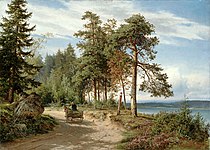 Road in Finland, 1865
Road in Finland, 1865
-
 Peasant Woman from Bayern, 1860s
Peasant Woman from Bayern, 1860s
-
 Birches in Summer, 1869
Birches in Summer, 1869
-
 Village Street in Schwartzwald, 1870
Village Street in Schwartzwald, 1870
-
 Landscape from Hohenaschau, 1871
Landscape from Hohenaschau, 1871
-
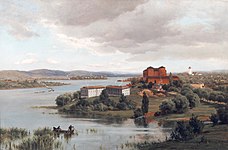 Häme Castle, 1872
Häme Castle, 1872
-
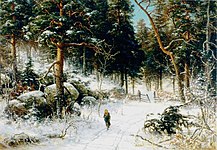 Winter Landscape from Tuulos, 1874
Winter Landscape from Tuulos, 1874
-
 Woodland in Hauho, Häme
Woodland in Hauho, Häme
-
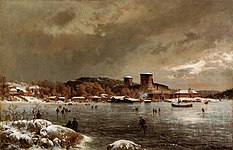 Olavinlinna (Winter), 1870s
Olavinlinna (Winter), 1870s
-
 Moonlight in Barösund, late 1870s
Moonlight in Barösund, late 1870s
-
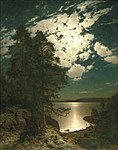 Moonlit Night, 1883
Moonlit Night, 1883
-
 October Evening After the First Snowfall, 1883
October Evening After the First Snowfall, 1883
-
 Morning Atmosphere (Island View), 1884
Morning Atmosphere (Island View), 1884
-
 Moonlight, 1885
Moonlight, 1885
-
 Crack Willows, 1897
Crack Willows, 1897
See also
References
- Directory of the Imperial Academy of Arts 1915, p. 134.
- ^ Reitala, Aimo (11 October 2005). "Munsterhjelm, Hjalmar (1840 - 1905)". Kansallisbiografia. Retrieved January 1, 2019.
- "Werner Holmberg". Biografiskt lexikon för Finland. Retrieved January 1, 2019.
- Frode Ernst Haverkamp. "Hans Gude". Norsk biografisk leksikon. Retrieved January 1, 2019.
- "Hjalmar Munsterhjelm: October Evening in the Archipelago after First Snow, 1883". www.ateneum.fi. Ateneum Art Museum. 2014. Archived from the original on July 14, 2014. Retrieved June 12, 2014.
- Divers (1878). Catalogue de la section russe à l'Exposition universelle de Paris [Catalogue of the Russian section at the Universal Exhibition of Paris] (in French). Paris: Lahure. Retrieved June 8, 2014.
- L. Baschet (Editor) (1900). Catalogue officiel illustré de l'exposition décennale des beaux-arts de 1889 à 1900 / Exposition universelle de 1900 [Official illustrated catalog of the decennial exhibition of Fine Arts from 1889 to 1900 / 1900 Universal Exhibition] (in French). Paris: impr. Lemercier (Paris). Retrieved June 12, 2014.
{{cite book}}:|last=has generic name (help) - Valjakka, Timo (12 July 2019). "Hämäläisen aatelisperheen lapsesta Hjalmar Munsterhjelmista kasvoi tunnettu taidemaalari, jonka maalauksissa Häme hehkuu romanttisena". Helsingin Sanomat. Retrieved 9 August 2020.
- "Munsterhjelm, John". uppslagsverket. Retrieved January 1, 2019.
- Piri-Lahti, Maarit (13 June 2019). "Yleisö rakasti Munsterhjelmin kuutamoa – meteorologi Seija Paasonen innostui hahtuvapilvistä". Yle. Retrieved 9 August 2020.
- Niskanen, Anne-Maria (20 September 2019). "Maisemataiteen mestarin, Hjalmar Munsterhjelmin kuutamot vetivät Hämeenlinnan taidemuseoon yli 13 000 vierasta". Yle. Retrieved 9 August 2020.
Literary sources
- С. Н. Кондаков (1915). Юбилейный справочник Императорской Академии художеств. 1764-1914 (in Russian). Vol. 2. p. 134.